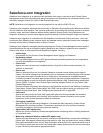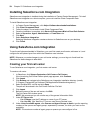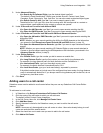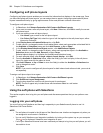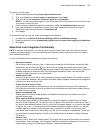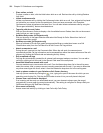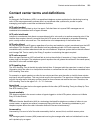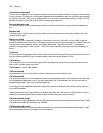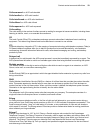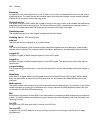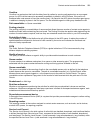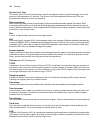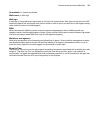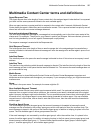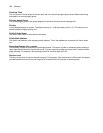Contact center terms and definitions 591
Calls answered see ACD calls handled
Calls handled see ACD calls handled
Calls interflowed see ACD calls interflowed
Calls offered see ACD calls offered
Calls requeued see ACD calls requeued
Calls waiting
The calls waiting is the number of callers queued up waiting for an agent to become available, including those
listening to silence, music, or a recorded announcement.
CO
The local Central Office (CO) or telephone exchange connects subscribers’ telephone lines to switching
equipment. This allows long distance and local subscribers to connect to one another.
CTI
Computer telephony integration (CTI) is the merging of computer technology with telephone systems. Today’s
PC-based telephone systems allow you to deliver synchronized voice and data delivery, voice and data
conferencing, automatic information retrieval for calls, caller-based messaging and routing, and desktop
productivity tools.
Delayed call
A delayed call is a call placed in the ACD queue because it cannot be immediately answered by an agent. The
ACD queue allows the caller to wait for an available agent rather than being blocked from entering the system.
Dialable number
The dialable number is the digit or series of digits a caller dials to reach an agent at an extension, an ACD
Queue, voice mail, or some other answering point.
DND
Do Not Disturb (DND) is an agent state in which the agent disables his/her extension to prevent any calls from
being routed there.
DNIS
Dialled Number Identification Service (DNIS) is a feature of toll-free lines that provides the number the caller
dials. This assists agents who handle calls for more than one business or product line. Each business or
product line has its own toll-free number. When a toll-free number is dialled, the telephone system forwards
information to the agent allowing him/her to identify who the caller dialled.
Enterprise
The enterprise is all of the contact center sites that comprise your company. The enterprise consists of a
single site where the Enterprise Server is installed, and branch offices.
Erlang
An Erlang measures telephone traffic, or the flow of calls and call attempts to your contact center during a
given period of time. One Erlang equals one hour or 60 x 60 = 3,600 seconds of telephone conversation. This
could be one call lasting 1 hour, six calls lasting 10 minutes, or any combination of calls and call durations
which equal 60 minutes. The Erlang series of formulae provide a mathematical basis for making predictions
about randomly arriving workloads.
Erlang C
Erlang C was developed in 1917 by A.K. Erlang, a Danish engineer who worked for the Copenhagen
Telephone Company. The Erlang C equation is commonly used for agent and delay calculations where ACD
queueing is involved. It predicts the resources required to keep wait (delay) times within your Service Level
objective. The Erlang C formula uses your historical Call Load data and the Service Level Percentage,
Service Level Time, and Wrap Up Time you specify and predicts the agent requirement for the time interval
and date range in the forecast.



